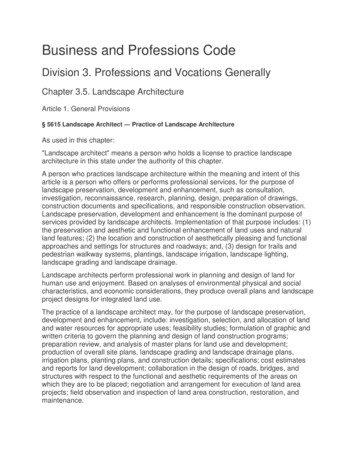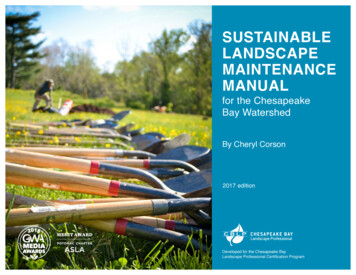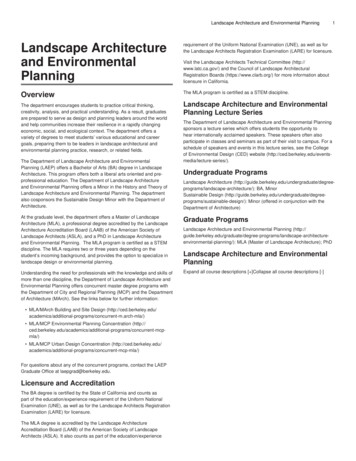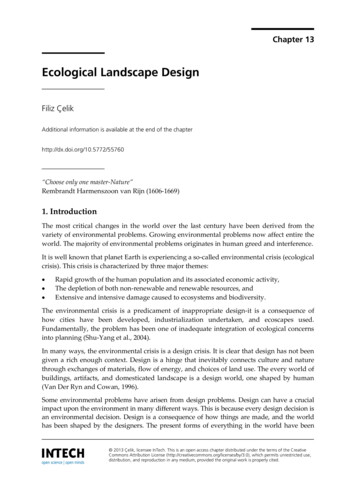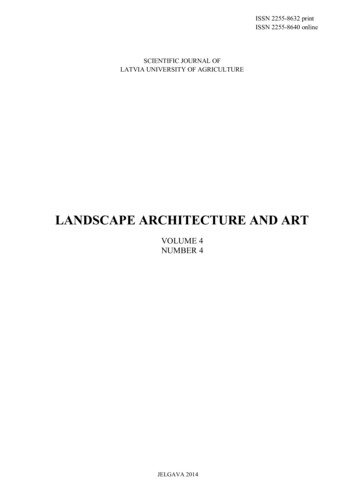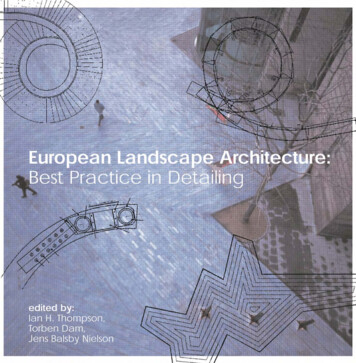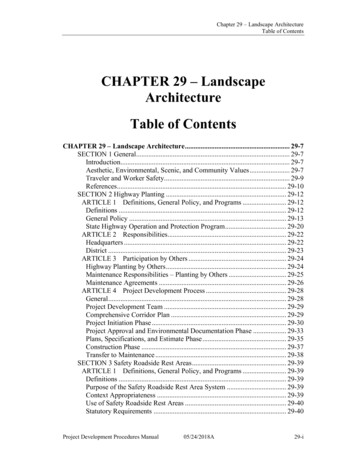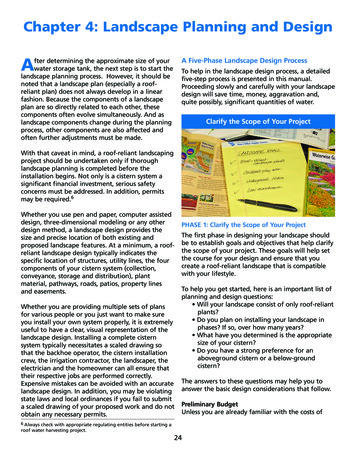
Transcription
Chapter 4: Landscape Planning and DesignA Five-Phase Landscape Design ProcessAfter determining the approximate size of yourwater storage tank, the next step is to start thelandscape planning process. However, it should benoted that a landscape plan (especially a roofreliant plan) does not always develop in a linearfashion. Because the components of a landscapeplan are so directly related to each other, thesecomponents often evolve simultaneously. And aslandscape components change during the planningprocess, other components are also affected andoften further adjustments must be made.To help in the landscape design process, a detailedfive-step process is presented in this manual.Proceeding slowly and carefully with your landscapedesign will save time, money, aggravation and,quite possibly, significant quantities of water.Clarify the Scope of Your ProjectWith that caveat in mind, a roof-reliant landscapingproject should be undertaken only if thoroughlandscape planning is completed before theinstallation begins. Not only is a cistern system asignificant financial investment, serious safetyconcerns must be addressed. In addition, permitsmay be required.6Whether you use pen and paper, computer assisteddesign, three-dimensional modeling or any otherdesign method, a landscape design provides thesize and precise location of both existing andproposed landscape features. At a minimum, a roofreliant landscape design typically indicates thespecific location of structures, utility lines, the fourcomponents of your cistern system (collection,conveyance, storage and distribution), plantmaterial, pathways, roads, patios, property linesand easements.Whether you are providing multiple sets of plansfor various people or you just want to make sureyou install your own system properly, it is extremelyuseful to have a clear, visual representation of thelandscape design. Installing a complete cisternsystem typically necessitates a scaled drawing sothat the backhoe operator, the cistern installationcrew, the irrigation contractor, the landscaper, theelectrician and the homeowner can all ensure thattheir respective jobs are performed correctly.Expensive mistakes can be avoided with an accuratelandscape design. In addition, you may be violatingstate laws and local ordinances if you fail to submita scaled drawing of your proposed work and do notobtain any necessary permits.PHASE 1: Clarify the Scope of Your ProjectThe first phase in designing your landscape shouldbe to establish goals and objectives that help clarifythe scope of your project. These goals will help setthe course for your design and ensure that youcreate a roof-reliant landscape that is compatiblewith your lifestyle.To help you get started, here is an important list ofplanning and design questions: Will your landscape consist of only roof-reliantplants? Do you plan on installing your landscape inphases? If so, over how many years? What have you determined is the appropriatesize of your cistern? Do you have a strong preference for anaboveground cistern or a below-groundcistern?The answers to these questions may help you toanswer the basic design considerations that follow.Preliminary BudgetUnless you are already familiar with the costs of6 Always check with appropriate regulating entities before starting aroof water harvesting project.24
Roof-Reliant LandscapingChapter 4: Landscape Planning and Designlandscaping and cistern systems, your preliminarycost estimates will probably have less to do with theactual costs of roof-reliant landscaping and cisternsystems than it will be based on how much moneyyou think you will have available for your project.This is the most realistic starting point available toyou at this stage in the process. Knowing that youcan adjust your budget as you receive moreinformation, you can now begin making decisionsabout your roof-reliant landscape.Your Commitment to MaintenanceBefore designing a landscape, it is important toconsider how much time you are willing to spendon landscape and cistern system maintenance.Many people find that the best landscapemaintenance plan consists of a combination of doit-yourself time and some occasional unskilledlabor and/or professional assistance.Domestic AnimalsDomestic animals can have a profound effect onany landscape. When establishing your waterdistribution lines (especially drip irrigation linesand other components that will be aboveground),take into account the possible effects thatdomestic animals might have on them.StorageThe landscape is often a place where certain largeitems need to be stored, including firewood,compost piles, toolsheds and recreational vehicles.Aboveground cisterns can sometimes hide theseeyesores, while an underground cistern cansometimes be buried underneath them.Use Worksheet 2 (on the next page) to helprecord and clarify the goals for your newlandscape.Outdoor Living AreasSometimes an excellent place for an undergroundcistern is under an outdoor living area—a placewhere people can relax, read, play games and/orhave a meal. Such a location depends on twofactors: (1) how often the system will needmaintenance and (2) how expensive is it to removeand replace the surface of the outdoor room. Forexample, it would be a mistake to install a cisternsystem that needs regular maintenance under anexpensive flagstone patio, but installing a cisternunder an easily removable shredded-bark surfacewould be appropriate.Children’s Play AreasCisterns can be situated appropriately undertemporary play structures, such as a lightweightswing set, a trampoline or a playhouse. However,placing such an item so close to where children playrequires extra diligence about ensuring that yourcistern’s serviceway remains locked and inaccessible(except when being serviced).Handicap AccessHandicap access (if needed) should be taken intoconsideration at the outset of the design process.Retrofitting a landscape to offer such access canbe an expensive proposition.Figure 4-1: A successful landscape begins with carefulplanning and design.25
Roof-Reliant LandscapingChapter 4: Landscape Planning and DesignWORKSHEET 2:SETTING GOALS FOR YOUR LANDSCAPE (Circle all that apply)1. Preliminary budget (first year) 5,000 5,000 -15,000 15,000-30,000 30,0002. Maintenance 1 hr./month3-6 hrs./month 6 hrs./month3. Outdoor living areas 4 people4-8 people8-12 people 12 people4. Children’s play areasYesNoSpecify5. Handicap accessYesSpecify1-3 hrs./monthNo6. Domestic animalsDog (dog run OK?)Cat (indoor OK?)7. StorageFirewoodCompost PileStorage/Toolshed8. Projected time before the sale of your property 3 years3-5 years5-10 yearsOtherRVOther 10 years9. Other26
Roof-Reliant LandscapingChapter 4: Landscape Planning and Design21st)? How does that shadow differ fromthat of the summer solstice (June 21st)?Evaluating the Site Slope. How will the slope of your propertyaffect where a cistern might be located? Vegetative cover. How can you use theexisting vegetation on your property for thebenefit of your future landscape? Whatplants might need to be transplanted toanother part of the property? Wildlife habitat. Which aspects of naturalwildlife do you want to encourage and/ordiscourage in your landscape?PHASE 2: Evaluating the SiteThe second step in the landscape design process issite evaluation. This consists primarily ofobservation and research. Use and traffic patterns. Observe and predictthe human activity that is likely to occur onyour property.ObservationBelow is a list of environmental factors that areimportant in landscape site evaluation. Take thislist out on your property at different times of dayand during different seasons of the year toobserve and take notes about these items. Manyof these factors combine to create microclimates,the small areas in your landscape that havedifferent growing conditions than those that existon your property as a whole. Views and privacy. What views do you wantto protect? Landscaping can be very effectiveat enhancing beautiful vistas and hiding uglyviews, and it can also be critical in creatingprivacy. Moisture. Where does the water fall fromyour roof? Where does moisture remain aftera heavy rain? Wind exposure. What direction do windstypically come from? Is there a time of dayand/or a time of year when the winds areextremely strong and persistent?ResearchStudying your site also requires gathering publicinformation about your specific region and yourparticular property. Your research should includeinformation provided by landscape professionals,surveyors and government agencies; it can alsoinclude many other sources of information such asfamily, friends and neighbors, especially those whohave lived in your community for many years.Topics to be included in your research at this pointin your design process include: Temperatures. Where are the hottest andcoolest spots on your property? Determiningthe location of hot and cool temperatures onyour land will help when it is time to decidewhich plants should be placed where. Shade and light. How far does your housecast its shadow on the north side of yourhouse during the winter solstice (December27Locations of utility linesProperty lines and easementsRestrictions on developmentPermitsSoil typesFrost datesFrost depthFlood potentialWildfire potentialLocal plant palette
Roof-Reliant LandscapingDevelop a Conceptual PlanChapter 4: Landscape Planning and Designwalls of permanent structures. Fixed features alsoinclude existing hardscaped areas, parking areas,driveways and pathways.Variable features are those that could work in more thanone place in your landscape. These can include cisterns,entertainment areas, play areas and planting beds.Your conceptual plan should also reflect theinformation about the natural features of yourlandscape that you gathered from your observationsand research in the site evaluation phase of thelandscape design process. You should indicate wheremoisture collects, where prevailing winds comethrough, where temperatures differ, where you'llhave summer shade and winter sun, where wildlifecorridors and habitat exist, and so forth.PHASE 3: Develop a Conceptual PlanThe third phase of landscape design is thedevelopment of a conceptual plan. Here, youintegrate the scope and goals of your design withyour site observations and evaluation. A conceptualplan provides the basic form of your landscapedesign, which includes the most importantrequirements of the plan with few details.It is important to place your cistern system somewhere on your conceptual plan, knowing that at anytime during the design process you can always changeits location, its relationship to grade and its size.Every conceptual plan shows three types of features:fixed, variable and natural. Fixed features includeproperty lines, easements, utility lines and exteriorFigure 4-2 (a finished conceptual plan) and Figure 4-3(a filled out Worksheet 2) show how the conceptualplan and the worksheet can work together.NFigure 4-2: This finished conceptual planshows the buried components for the entire site.28
Roof-Reliant LandscapingChapter 4: Landscape Planning and DesignWORKSHEET 2:SETTING GOALS FOR YOUR LANDSCAPE (Circle all that apply)Figure 4-3: A filled-out worksheet shows the goals for the landscape.29
Roof-Reliant LandscapingChapter 4: Landscape Planning and DesignGenerate Various OptionsChoose a DesignPHASE 4: Generate Various OptionsNow it is time to determine options for thelandscape features you will have on your propertyand where they will be placed in relationship to eachother. Based on your conceptual design, start todetermine the places where the various features ofyour landscape might best be located.PHASE 5: Choose a DesignChoosing a design for your final roof-reliant system isa very personal decision. It involves your particularsense of aesthetics, your level of desire for beingoutdoors, your finances, your level of commitment toroof reliance and many other factors.In order to provide you with some basic knowledgeabout important landscape features that are ofparticular interest to the roof-reliant landscaper, wehave developed a list of common roof-reliantlandscape features. It is not necessary to include allof these features in your landscape design.The common roof-reliant landscape features are: Cistern system Erosion and drainage control Plant material Hardscape Fences and walls Recreation areas LightingFor many homeowners, the selection process beginswith a narrowing down of choices. If financial factorsare of primary importance, some of the moreexpensive options may be rejected at this point. Ifaesthetics are your number one concern, thenperhaps aboveground tanks can be ruled out.At this stage in the process, define and locate theset of rooftop water harvesting options that youwill work with as you proceed with your project.This design is not necessarily the only or best finaloption; it is simply a draft to work with during therest of the planning process.Locate and define walkways, patios, walls and otherhard surfaces that may contribute to the wateravailable to plants. Place the largest plants—theshade trees, vines and shrubs needed for privacyand/or wind screening. Then overlay the accentplants, groundcovers and other smaller plants youare considering for seasonal color and texture so thatyou begin to have a sense of how much total surfacearea will be planted.At this point, you do not need to decide what eachspecific plant will be, but do think about which areaswill be the most xeric and which will act as “oases.”You may want to note favorite plants so that theyget first consideration when you begin matching theplanting plan to the water budget.30
To help in the landscape design process, a detailed five-step process is presented in this manual. Proceeding slowly and carefully with your landscape design will save time, money, aggravation and, quite possibly, significant quantities of water. PHASE 1: Clarify the Scope of Your Project The first

